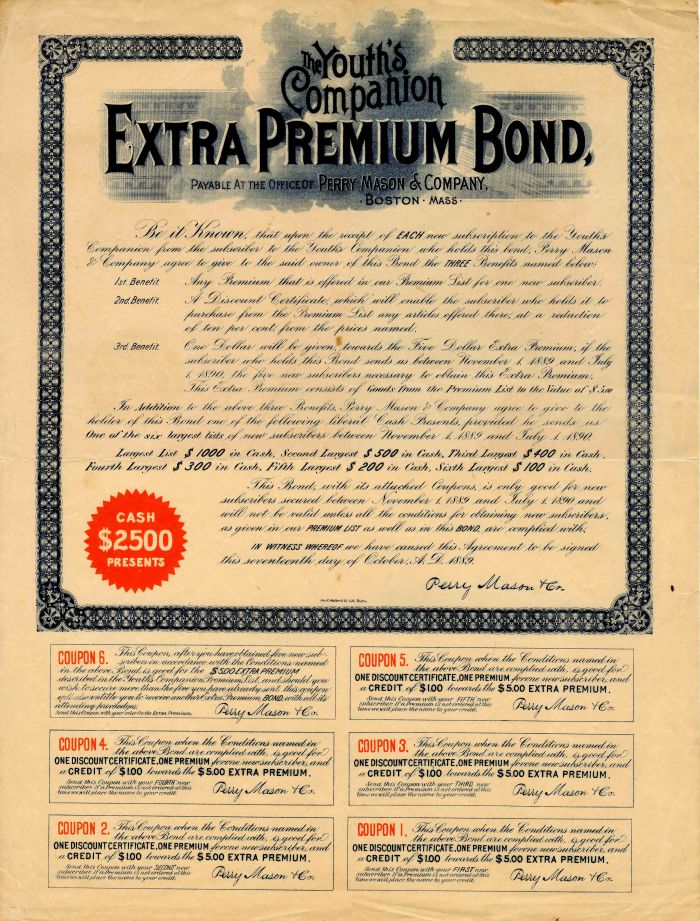Youth's Companion Extra Premium Bond - Children's Magazine - Americana
Inv# AM1449 Bond
This Bond is payable at the office of Perry Mason & Company to the subscriber of the Youth's Companion. Very Unique!
The Youth's Companion (1827–1929), known in later years as simply The Companion—For All the Family, was an American children's magazine that existed for over one hundred years until it finally merged with The American Boy in 1929. The Companion was published in Boston, Massachusetts by Perry Mason & Co., later renamed "Perry Mason Company" after the founder died. The revised name first appears on the August 9, 1900 issue. From 1892 to 1915 it was based in the Youth's Companion Building, which is now on the National Register of Historic Places.
Early issues of the Companion were centered on religion, having been created, in the words of its first publishers Nathaniel Willis (father of Nathaniel Parker Willis) and Asa Rand, to encourage "virtue and piety, and ... warn against the ways of transgression". In its early years its circulation did not reach 5,000.
Through the years, publishers included Willis & Rand (Washington St., c. 1831); Olmstead & Co., (School St., c. 1857); and Perry Mason & Co. (Washington St., ca.1868; Temple Place, c. 1873–1888; and Columbus Ave.; c. 1894).
In the 1890s its content was re centered on entertainment, and it began to target adults as well as children with pieces contributed by writers such as Harriet Beecher Stowe, Mark Twain, Emily Dickinson, Booker T. Washington, and Jack London. Another innovation was a medical column for older readers. In consequence, its circulation increased one-hundredfold, with sales peaking in 1893. It was advertised in 1897 as "an Illustrated Family Paper", having, as one person said of it, done "away with childish things". It did, however, retain a children's section, which included short poems and puzzles, and in faith to its beginnings, however, The Youth's Companion did not mention nor advertise drugs or alcohol, nor did it delve much into politics; when it did, it usually did so in a humorous way.
On September 8, 1892, the magazine published the first copy of the Pledge of Allegiance, written by staff member Francis Bellamy.
From 1893–1907, Johnson Morton (Harvard 1886) served as an editor. In later years the magazine published articles from Willa Cather and Winston Churchill.
Erle Stanley Gardner (1889–1970) was, as a child, very fond of the magazine. When he embarked on his own writing career, Gardner borrowed the name "Perry Mason" for his famous fictional attorney-detective.
In the 1947 movie Life with Father, which is set in the 1880s, the children of the family mention reading The Youth's Companion.
The Youth's Companion Building is a historic building at 209 Columbus Avenue in Boston, Massachusetts. The building is also known as the Pledge of Allegiance Building because the Pledge of Allegiance was written and published there. The building originally had the address 201 Columbus Avenue and also has the address 142 Berkeley Street. It was built in 1892 and added to the National Register of Historic Places in 1974.
It housed the offices of The Youth's Companion, the magazine owned and edited by Daniel Ford that promoted the Pledge of Allegiance. Ford built the building for The Youth's Companion and moved the magazine's headquarters there in 1892, where it remained until 1915, when the magazine moved to a new building near the current Boston University.
Ford's monumental, five-story building combined beauty and artistic qualities with good design and lay out for a publishing business, with natural light from windows and skylights. His style was the round-arched, squat-columned, masonry-exalting Romanesque. This five-storied building Richardson designed for The Companion is of brown sandstone and matching brick, as solid and impressive as a bank. Great arched windows and heavily recessed and arched doors characterize the street facade. Passing beneath the great arch, one enters a great vestibule two stories high. Throughout the interior the woodwork was of oak with heavily carved oaken benches for waiting visitors.
The architects, Henry W. Hartwell and William Cummings Richardson, also designed a number of other buildings in the Boston area, notably the Belmont Town Hall and Christ Church, Andover.
When used by The Youth's Companion, the first floor of the building held the business office, correspondence department, subscription and advertising departments with Ford's office in the back. The third floor held the premium department, packing and mailing room, and stitching machines. The fifth floor contained the editorial offices, art department and library that had an encyclopedic collection of clippings from over 200 magazines from around the world. The press room was in the basement along with the presses, collators, steam tubular boilers for power binding equipment and two dynamos which generated electricity for lighting.
A bond is a document of title for a loan. Bonds are issued, not only by businesses, but also by national, state or city governments, or other public bodies, or sometimes by individuals. Bonds are a loan to the company or other body. They are normally repayable within a stated period of time. Bonds earn interest at a fixed rate, which must usually be paid by the undertaking regardless of its financial results. A bondholder is a creditor of the undertaking.









Ebay ID: labarre_galleries